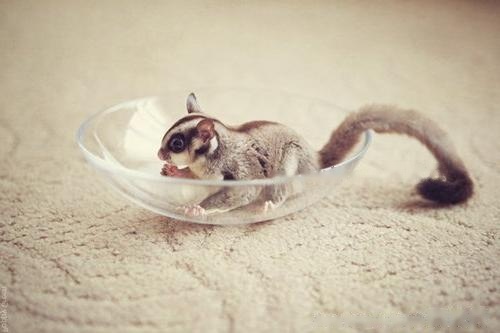The honey glider is a small pet that is afraid of being alone, so try to keep a pair when raising it, so as to reduce its loneliness, and it is also a nocturnal animal. Usually sleep during the day because the light is too strong. In order to better raise the honey glider, what living habits should we know about it?

Glider
Physiological data of Glider
Lifespan: The lifespan of Glider in the wild is short, about only Four or five years. Captive-bred honey gliders may live up to twelve years or more.
Body length and weight: Adult male gliders are heavier than females, 115-160 grams and 95-135 grams, respectively. The body length is 12-13 cm, and the tail length is 15-48 cm.
Age of sexual maturity: about 8-14 months.
Pregnancy period: about 16 days, but immediately after delivery, the baby crawls into the mother's belly bag to express breast milk, and weaning after about 70 days. Most female gliders can only conceive 1-2 at a time, and the chance of having more than 3 fetuses is very low.
Gender identification: The male glider's scrotum is located in the center of the lower abdomen, and there are secretory glands on the front chest and top of the head, which are used to indicate their sphere of influence. The midline of the female glider's abdomen has a pouch opening parallel to the body. Males and females are easy to identify.
Body temperature: Gliders have a low body temperature, about 32 degrees Celsius.
Glider's diet
Sweet, but not too much. Marsupials have poor regulation of high blood sugar, and foods with high sugar and fat content will threaten their health. The honey glider is an omnivorous animal, and its food content is more focused on protein food. Wild honey gliders like to eat all kinds of insects, especially when they are breeding, the intake of protein food is more than 50%. In addition to insects, they also like to eat fruits and tree honey.
Simply put, there are four principles for the selection of sugar glider food:
1. The protein content should not be less than 25%, and it is better to be higher than 50% during the breeding period .
2. Provide clean drinking water at all times.
3. Regularly supplement calcium and other vitamins and minerals.
4. Give less food with high fat and polysaccharide.
The honey glider is a gregarious animal, a typical member of a group consisting of one male glider of the highest status, two second-ranked male gliders, and four mature females. As long as food is plentiful and family members live in peace, the group may number as many as 12. In other words, when artificially raising honey gliders as pets, at least one pair should be kept. Sugar gliders that lack companions may self-mutilate because of boredom. The newborn honey glider is hairless and weighs only 200 mg. (approximately the size and weight of a small capsule) remains in the mother's belly pouch until the eyes are opened at 70 days of age, and the hair on the body is fully grown. Young gliders at this stage can leave their mother's pouch and explore the environment. Before this age, if the female glider dies unexpectedly, or the young glider accidentally falls out of the belly bag, the chance of survival of the captive hairless young glider is almost zero. Therefore, the owner must not forcibly open the belly bag of the female glider in the swaddling clothes because of a momentary curiosity, so as to avoid the death of the young glider.
Captive breeding environment. There is a layer of skin between the fore and hind limbs of the honey glider. This layer of skin allows them to jump from heights and glide up to 50 meters in the air like flying squirrels. It can be seen from this that the larger the breeding environment, the more ideal. Generally speaking, the minimum space for the cages for non-pet gliders is 1.8m-1.2m-1.8m in length-width-height respectively. In order to prevent the honey bag glider from getting out of the cage, the size of the cage net should not be larger than 1X2.5 cm.
![[Dog Training 5] The training method of pet dog dining etiquette](/static/img/12192/12192_1.jpg)




